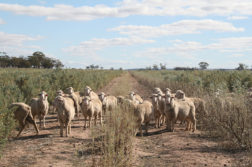Australia’s resources companies have enjoyed sky-high commodity prices for years. Shipped and sold to China and the other industrialising countries to our north, these commodities have made a lot of people very rich and have driven a huge boom in mining investment, from the giant yellow trucks used to haul ore on mine sites, to the tens of thousands of high-paying jobs created in Queensland and Western Australia.
As a result, the parts of the Australian economy directly linked to the mining boom have prospered like almost no other part of the rich world. A modern gold rush has created new towns and cities almost overnight, in places like Moranbah, Gladstone and Port Hedland.
For years, the Australian taxpayer benefited too. The huge profits generated by the big resources companies meant large tax returns for the federal Treasury, even if most of the profits eventually found their way overseas to international investors. The macro-economic felicities for the lucky country were such that while the commodities we sold to Asia soared in value, the flatscreen televisions and computers we imported continued to fall in price.
The mining boom has, obviously, boosted economic growth. The vast sums of money being spent on iron ore mines and gas rigs has filtered through to Australia’s national accounts, propping up our GDP figures even as some parts of the economy dropped into neutral or reverse. Some of this money has eventually spilled over into the rest of the Australian economy, not least through the agency of repeated income tax cuts to workers on the back of increased company tax revenue.
It hasn’t all been good news.
The vast flow of mineral wealth leaving our shores has jacked up the price of the Australian dollar on international money markets, making our manufacturing sector increasingly uncompetitive. Australia’s once-proud car and steel makers are shutting up, closing down and moving overseas, despite billions in government hand-outs that have vainly tried to protect vanishing jobs. Because far more Australians work in manufacturing than mining, this has meant that the employment impact of mining has been tempered. There have also been severe growing pains in the mining states of Queensland and Western Australia, which have struggled to keep up with infrastructure provision.
Now, a new threat looms on the horizon. Could the mining boom and its associated "commodities super-cycle" finally be coming to an end? If so, what will that mean for the Australian economy? Will we all be rooned, as Hanrahan famously intoned in John O’Brien’s 19th century poem?
In its June Business Outlook survey, Deloitte Access Economics argued that the mining boom may well be ending. "With global prospects under a cloud, investment question marks already on the horizon and both sides of politics pandering to populism, Australian exceptionalism is at risk of coming a cropper down the track," the report says. "We didn’t celebrate our happy 21st birthday without a recession on July 1 because we were too busy seeing a glass half-empty."
Access’ prominent director, the media-savy Chris Richardson, was out and about in his typically chipper manner. "A striking investment boom continues to do all the heavy lifting on our growth," Richardson cautioned. "Yet the peak of the project pipeline is already in sight, meaning the key prop to the faster part of Australia’s two-speed economy is looking less certain the further out you look — though there’s still enough gas in the tank of huge resource projects to provide handy pipeline protection if Europe and China were to turn pear-shaped."
Access’ caution has been picked up on by other analysts. Today, Newport Consulting was in the news for its recently-released Mining Business Outlook, which argues that sentiment has turned negative for many companies in the resources sector. "Across the board, we’ve seen a significant shift in sentiment to the negative in the belief that commodity prices will remain high enough to make future investments pay off," the report’s author David Hand told AAP.
What’s driving this sudden pessimism is no secret. Demand for Australia’s commodities has moderated, while costs have increased. Iron ore spot prices are currently trading below $120 a ton, far from their heights in the $170 range in previous years. Demand from China’s steel mills is tepid, and stockpiles of the raw material are growing. Prices for thermal coal have also slacked off, drive in part by defaults on payment in China resulting in coal being dumped on a weak Indian market.
Meanwhile, the costs of building and completing giant resources projects continue to spiral ever-upwards, putting pressure on resources companies to eventually turn profits. Newport thinks that some $200 billion in mining investment is at risk of being cancelled.
All commodity booms do eventually come to an end. In previous busts, Australia has suffered badly, with investors burnt, companies pushed to the wall and the nation pushed into recession. Perhaps the best-known Australian example was the boom and bust in nickel stocks in the late 1960s, especially the mania surrounding nickel explorer Poseidon (pdf). After announcing a big nickel find in Western Australia, the stock price of junior miner Poseidon rocketed from 80c to $280. At its peak, Poseidon was worth a third of BHP’s market capitalisation. It hadn’t even started producing nickel. The Poseidon adventure wiped out many small investors and led indirectly to tougher regulation of Australia’s stock exchange.
There’s no reason to believe the current commodities boom will last forever. Even though China and India will continue to industrialise, at some point expanding global production will catch up with demand, and commodity process will decline, perhaps crash.
But, as with all crashes, predicting the timing of a turn in the market is fiendishly difficult. Access have got it wrong many times in the recent past. There is no reason to believe that it is right this time. And market declines can take many shapes. Sometimes the markets can fall off a cliff, as happened in September 2008. But sometimes they stabilise and then correct over a long period. Australia’s mining stocks may indeed be over-priced. But big companies are still making money — lots of money — and their investment is still pumping hundreds of billions into the economy.
Even the pessimistic Newport report still notes that $150 billion in gas investment is locked in, in addition to all the other massive projects underway across Australia’s north. In this year’s budget, the Treasury boffins thought that the locked-in investment was even greater than this, perhaps half a trillion dollars.
And what would happen if commodities declined sharply, and the mining sector contracted? Certainly, there would be pain in regional Australia. But there would also be counter-balancing benefits across the economy. The Australian dollar would fall, making exports more competitive generally. This would help businesses that export, as well as those that compete with imports. Wayne Swan might not get the mining tax bounty he hopes for. But there would be benefits that would accrue to Australia generally, as our economy rebalanced away from mining and back towards more mundane goods and services.
In fact, as the Australia Institute’s Richard Denniss and Matt Grudnoff have argued, the cost pressures and wage rises in mining that everyone is complaining about are being driven by the crazed rush to develop huge numbers of big projects all at once. This has caused skills shortages and infrastructure bottlenecks. Denniss and Grudnoff think there should be a government cap on large mining projects. This would prevent the sector from over-heating, and ensure that only the most profitable go ahead.
"The national debate surrounding the mining boom, to the extent that there has been one, has tended to focus on the extreme positions that the mining boom is either ‘universally good’ or ‘universally bad’", they observe, sagely. "Such a debate has largely prevented the conduct of a national debate about how to best manage the mining boom to extract the maximum benefits for Australian citizens while minimising the costs that are imposed by the boom on other sectors of the economy and society."
In other words, a slow down in mining might quite a good thing in the long run, including for the mining industry itself. Mind you, don’t expect to hear too many analysts arguing that.
Donate To New Matilda
New Matilda is a small, independent media outlet. We survive through reader contributions, and never losing a lawsuit. If you got something from this article, giving something back helps us to continue speaking truth to power. Every little bit counts.



